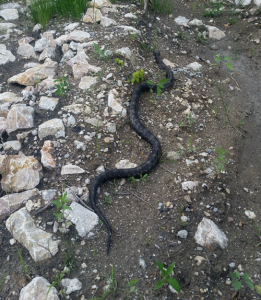Should I be Concerned If There Are Snakes in my Yard?

Imagine you’re outdoors enjoying a cool evening breeze in your garden. Or imagine you’re in your house searching for an item you’ve misplaced. Suddenly, you see a snake cramped up in a corner or slowly crawling across the floor. What’s going to be your first reaction? For most people, a shiver of fear runs down their spines. Our innate fear for snakes can be traced to our evolutionary history, where our ancestors learned that being bitten by a venomous snake was usually fatal.
Now, we know that our level of irrational fear is unjustifiable as the vast majority of snakes are 100 percent harmless to humans. Moreover, as a general rule, snakes are just as frightened when they come in contact with humans and would often move as quickly as possible in the opposite direction. Even venomous snakes rarely bite humans. They do so only when they feel threatened. Therefore, what is the proper way to act if you encounter a snake in your yard? Before we delve into this, let’s take a quick dive into what might be possibly attracting them in the first place.
Why are Snakes in Your Yard?
If there’s a snake in your yard, it probably means that your yard is a healthy ecosystem in which they can thrive. Think about it, most snakes usually dine on rodents, insects, birds, frogs, lizards, eggs, fish and small mammals. Therefore, snakes are usually attracted to where
they can obtain such food sources. A healthy garden is a perfect spot. If you have poultry, the eggs might also attract snakes.

Now, we know snakes are not actively out to harm us or even our pets. Only the largest of Pythons and Anacondas have been known to eat preys as large as pigs and deer. Let’s face it, it’s improbable that you come across them in your yard.
What to Do If You See a Snake in Your Yard.
The first thing to do is to determine the species of the snake. It’s indeed difficult to tell the difference between a poisonous and harmless snake. However, try to familiarize yourself with the difference. If it’s a non-venomous snake and it’s outdoors, continue to leave it alone. Most times, these snakes might just be passing through, unlikely to be seen ever again. On the other hand, if it’s a venomous snake, you have to take the matter seriously to ensure that no one, including your pets, is at risk of getting hurt. The best course of action is to call animal-control or a pest removal service to remove the snake from your territory. Most importantly, if you are bitten by any kind of snake, seek medical attention as soon as possible.
How to Prevent Snakes in Your Yard.
Excluding snakes from your yard can be as challenging as excluding rodents. However, specific steps can be taken to limit their presence in your yard and ensure that they do not get into your home. Some of the most common steps include:
Tidy up the Yard
Ensure that your property is inhospitable to snakes by eliminating good hiding spots for snakes. Remove debris, flat boards, piles of leaves, and piles of stones. Also, ensure that your vegetation is cut back.
Cut the Food Supply
Find ways to stop serving the snake’s preferred menu. This includes harnessing pest control to eliminate rodents and lizards. Also, you want to avoid leaving your pet food outside for long. Furthermore, avoid over-watering your lawn as this will attract slugs and frogs, which in turn will attract a hungry snake.
Seal Cervices
Check clearances of door bottoms, holes, pipes, cracks, spaces under eaves – and seal any opening that might be compromised. Consider a snake-proof fence Although snake-proof fences are pretty expensive, it’s wise to consider it if you live in an area where venomous snakes are prevalent. Furthermore, ensure that nothing hangs over your fence through which a snake may scale through.
